Overview of modern cast-iron heating radiators: old traditions in a designer way
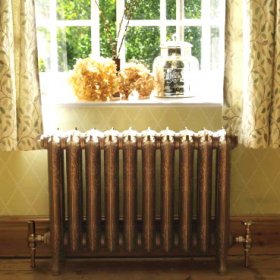
In cold weather, the temperature in the house should be such that it does not feel street cold, but is comfortable and warm. In our country, the most common are central heating systems in which the coolant is water. In such systems, the main heating elements are, as a rule, cast-iron heating radiators. Their practicality is time-tested, because they have been used for over 100 years.
In the last century, a Soviet apartment and a cast-iron battery were almost synonymous. It was a kind of multifunctional heat device, which was used not only for heating the room, but also for drying clothes, wet shoes, for defrosting and drying foods, etc. They were installed everywhere, since there was no alternative. Today, cast-iron batteries are gradually replacing steel, aluminum and bimetallic models from the market, devoid of the drawbacks inherent in cast-iron units. But, despite the existing variety, cast-iron radiators for many reasons continue to be in demand. What is the reason for their popularity? Let's figure it out.
Content
How do these radiators differ from others?
The use of cast-iron heating radiators in centralized and autonomous heating systems is also relevant in the present century due to their good technical characteristics, which should be considered in more detail:
- Cast iron is corrosion resistant. This is important because in the warmer months, water is drained from the system and very suitable conditions are created for corrosion processes. It can withstand high temperatures - up to 150 ° C, so it can be used in steam heating systems.
- Durability. This is one of the most significant benefits. With proper operation, which includes regular maintenance, the service life of cast iron radiators is about 50 years.
- Immunity to the quality of the coolant. The quality of the water used in heating systems leaves much to be desired. The rust particles present in it, various chemical compounds, an alkaline environment with a high pH do not cause significant damage to the inner surface of the radiator. Dissolving or scratching cast iron is not so easy!
- Resistance to clogging. A wide cross-section of the channels ensures the normal circulation of the coolant even in the presence of some deposits or foreign objects in the system.
- Large wall thickness, which ensures the durability of the device. For open heating systems with a high oxygen content and seasonal emptying, cast iron radiators are ideal.
- Excellent heat storage ability. Due to its thermal inertia, cast-iron batteries retain and transfer heat for a fairly long time after an emergency shutdown of the heating system. If for steel and aluminum radiators an hour after shutdown, the residual heat transfer is 15%, then for cast-iron radiators -30%. Given that such heat supply outages often happen in our realities, a cast-iron battery can make this unpleasant phenomenon almost invisible.
- Low cost. An essential factor in the popularity of cast iron batteries is their availability to the majority of the population. They are much cheaper than analogues from other metal alloys, and since they most often equip not one room, but the whole house, sometimes multi-storey, the savings are noticeable.
In addition to the noted advantages, cast-iron units have some disadvantages. So, they have a lot of weight and impressive dimensions, which makes their installation difficult. For 1 kW of heat, an average of 45 kilograms of battery weight is consumed. They are much inferior in this indicator to their steel, aluminum and bimetal counterparts.
Such units withstand pressure not exceeding 15 atm, unlike bimetallic, which can withstand all 40. They have low heat dissipation, and as a result - slow heating of the room. And also, their intersectional space has a complex shape, and therefore the radiator is very difficult to clean from dust.
You will learn about the advantages of aluminum radiators over others in our material:https://aquatech.tomathouse.com/en/otoplenie/radiatory/alyuminievye-radiatory-otopleniya.html.
What to consider when choosing these batteries?
When choosing a cast iron radiator that is suitable for your conditions, several technical criteria should be considered. These are, first of all, heat transfer parameters, which are selected in accordance with the dimensions of the heated room. Also may be interested in the overall weight of the radiator, height, width, depth, power, etc.
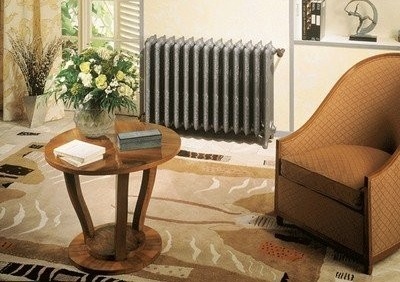
In the minds of our compatriots, cast-iron batteries are associated with reliability and durability: they have proven their worth over many decades.
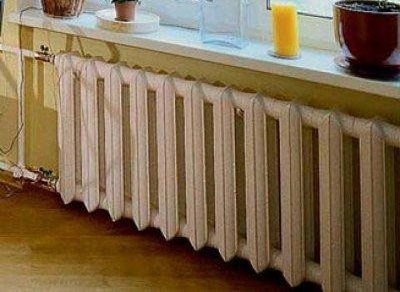
This is how the “legendary” cast-iron heating radiator of the last century looks, which even today prevails in most apartments of multi-storey buildings
To calculate the thermal power of a cast iron radiator for each room separately, you need to focus on the following rule:
- for heating a room with one window and one external wall, 1 kW of thermal power per 10 m is required2 living space;
- a room with 1 window and 2 external walls will require 1.2 kilowatts for every 10 m2;
- for heating a room with two windows and two external walls for every 10 m2 1.3 kilowatts of power will be required.
In addition, you need to pay attention to such nuances:
- the required power will increase proportionally if the ceiling in the room is higher than the standard (3 m);
- in the presence of windows with double-glazed windows, battery power can safely be reduced by 15%.
After knowing how many kilowatts 1 section of the selected radiator produces, you can calculate the required number of sections. It is also important to know that if there are several windows in the room, it is recommended to install a radiator under each of them. This will significantly reduce heat loss.
To reduce your calculation time, we suggest using our online calculator (heat transfer from cast-iron radiators ~ 110 W):
Fields are filled incorrectly. Please fill in all fields correctly to calculate the number of sections
The dimensions of cast-iron radiators are different, but for standard models the center distance is 500 mm, the depth is 110 mm, and the width of the sections is from 40 to 60 mm.
What does the modern market offer?
How do they differ from older models? First of all, original design. If earlier cast-iron radiators did not have an entirely attractive appearance due to their unaesthetic shape and rough surface, today designers have worked wonderfully with their appearance.On their surface is depicted a beautiful ornament suitable to the style of the room.
They have smaller dimensions, improved heat-shielding properties. The vertical arrangement of the ribs provides high heat transfer and dust in them is easier to wipe. A variety of sizes makes it possible to rationally arrange cast-iron radiators of a new generation even in rooms with a very small window sill. An important addition to some cast-iron heating devices of a new generation are legs. There is no need to spoil the walls by driving brackets into them. The battery is simply installed on the floor and connected to the heating circuit.
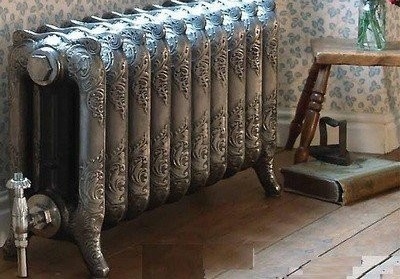
A new-generation cast-iron radiator can become a worthy element of the room’s interior and ideally fit the design styles

Feet are an important addition to modern cast-iron heating elements. There is no need to drill walls, drive brackets into them - the device is installed directly on the floor
As for color, today you will not surprise anyone with green and purple tones, copper and bronze, silver and gold. Recently, reproductions of old models - radiators repeating old designs - have become extremely popular. They are decorated with art casting, equipped with appropriate fittings. Such exquisite models of radiators ennoble the interior, become part of it. Of course, such devices are more expensive than ordinary simple ones, but you can choose a product to your liking and preferences.
Imported and domestic models - which are better?
England and Germany, Italy and the Czech Republic, Spain and Turkey offer their products. It differs from the domestic one to a large extent in higher quality and aesthetic surfaces. An important distinguishing feature is the increased thermal power of the device with smaller dimensions. For example, with the same heat transfer, the classic Russian radiator MS-140 has a volume of 1.3 liters, and Czech batteries - only 0.8 liters. Thus, the Czech version will be more compact than the domestic one.
For imported samples, the inner surface is almost perfectly smooth, which reduces the resistance to movement of the coolant, as well as the formation of scale layers on the walls of the device. In addition, imported options are sold in painted form, while domestic ones require painting after installation. It should be noted, however, that imported products always cost much more than domestic ones.
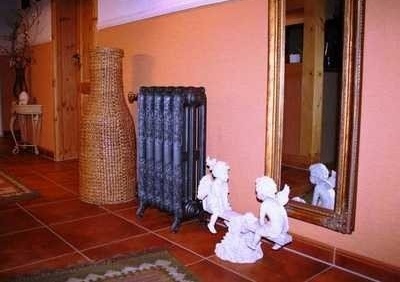
Imported cast-iron batteries go on sale immediately painted, and domestic ones need to be painted after installation
Read also our overview material about other types of heating radiators and how to choose them:https://aquatech.tomathouse.com/en/otoplenie/radiatory/kak-vybrat-radiatory-otopleniya.html.
Cast iron radiators are a perfectly acceptable option for the heating system, both in apartments and in private houses, and are still popular among the population. And so that they serve for a long time, the main thing is to correctly install and qualitatively connect detachable connections.
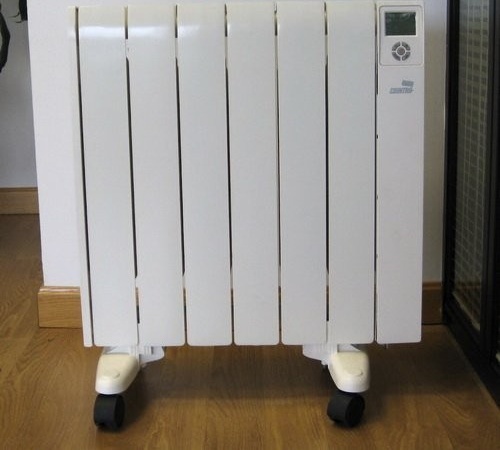
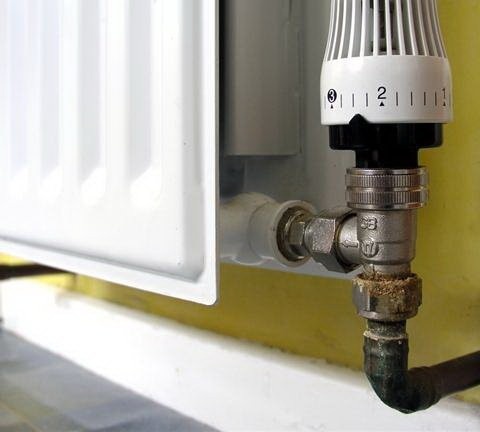
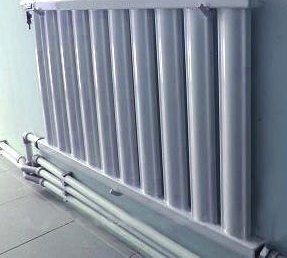
6 comments